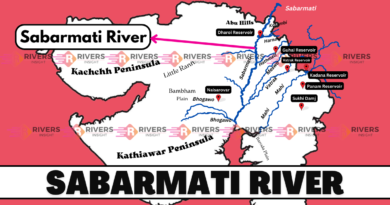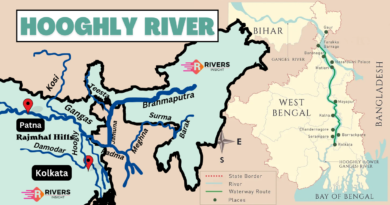Indus Water Treaty of 1960: India & Pakistan [Map]
The Indus Water Treaty (IWT) is regarded as one of the most successful water-sharing agreements in the world. Signed in 1960 between India and Pakistan, and brokered by the World Bank, the treaty governs the use of waters from the Indus River and its tributaries.
However, following the recent Pahalgam terror attack in Kashmir, India has announced the suspension of the treaty, marking a major shift in regional water diplomacy.
Table of Contents
What Is the Indus Water Treaty?
The Indus Water Treaty, signed on 19th September 1960 in Karachi, allocated the six rivers of the Indus basin between India and Pakistan.
- India was given control over the Eastern Rivers — Ravi, Beas, and Sutlej.
- Pakistan received rights over the Western Rivers — Indus, Jhelum, and Chenab.
Key Facts About the Indus Water Treaty
- Brokered By: World Bank
- Signed By: Jawaharlal Nehru (India) and Ayub Khan (Pakistan)
- Permanent Indus Commission (PIC): Established for cooperation and dispute resolution.
- Water Sharing:
- Eastern Rivers (Ravi, Beas, Sutlej) → India
- Western Rivers (Indus, Jhelum, Chenab) → Pakistan
- Dispute Resolution Mechanism: Three-tiered structure involving Permanent Indus Commission, Neutral Expert, and Court of Arbitration.
- No Exit Clause: The treaty is permanent with no unilateral withdrawal allowed.
Indus Water Treaty History
- 1947 Partition: The boundary cut across the Indus basin, leaving Pakistan heavily dependent on river water flowing from India.
- Early Disputes: Control over Madhopur and Ferozepur headworks created tensions.
- World Bank Mediation: Negotiations led to the formal treaty in 1960, ensuring equitable water sharing and reducing conflict risks.
Indus Water Treaty Map Overview
- Indus River: Originates in Tibet, flows through Ladakh into Pakistan.
- Jhelum and Chenab: Pass through Jammu and Kashmir before entering Pakistan.
- Sutlej, Beas, and Ravi: Flow through Punjab into Pakistan.
Why India Suspended the Indus Water Treaty?
After the Pahalgam terror attack, the Indian government, led by Prime Minister Narendra Modi, decided to suspend the treaty. This move signifies that continued cross-border terrorism will have direct consequences on existing agreements.
Implications for Pakistan
- Water Dependency: 80% of Pakistan’s agriculture relies on the Indus water.
- Urban Impact: Cities like Karachi, Lahore, and Multan depend heavily on these rivers.
- Economic Threat: 23% of GDP and 68% of the rural population depend on agriculture, which uses 93% of water resources.
- Existing Crisis: Pakistan already faces groundwater depletion and weak water storage capacity.
- Vulnerability: Loss of treaty protection intensifies national insecurity over the water supply.
Implications for India
- Increased Control: Greater autonomy over the usage of the Indus, Jhelum, and Chenab rivers.
- Hydropower Development: Enhanced potential to build projects without previous restrictions.
- Flood Management: Improved capacity to manage floods in the Kashmir valley.
- Strategic Leverage: Suspension of site inspections and flood data sharing weakens Pakistan’s position.
- Infrastructure Limitation: Immediate effects are limited as India’s infrastructure to halt or divert water is still developing.
Indus Water Treaty Disputes and Legal Limitations
- Design Disputes: Projects like Kishanganga and Ratle dams sparked disagreements.
- No Peaceful Enforcement: If India steps out of the treaty, Pakistan has no legal recourse through the International Court of Justice (ICJ).
- Treaty Modification Attempts: India recently proposed treaty modifications, citing climate change and obstruction by Pakistan.
Indus Water Treaty Timeline: Important Events
| Year | Event |
|---|---|
| 1960 | After the Pulwama Attack, India maximizes the use of eastern rivers |
| 2013 | Arbitration ruling on Kishanganga Dam |
| 2016 | Post-Uri Attack, India suspends Indus Commission meetings |
| 2019 | After the Pulwama Attack, India maximizes the use of eastern rivers |
| 2023 | India proposes treaty modifications |
| 2024 | India issues notice to amend the treaty |
| 2025 | After the Pulwama Attack, India maximizes use of eastern rivers |
Conclusion
The Indus Waters Treaty once stood as a symbol of peace and cooperation between India and Pakistan. Today, amid rising cross-border tensions, it is becoming a strategic tool for national security. Prime Minister Modi’s words, “blood and water cannot flow together,“ now define the future of Indo-Pakistan water relations.
The suspension of the treaty could reshape regional geopolitics, emphasizing that diplomacy and security are deeply intertwined.




